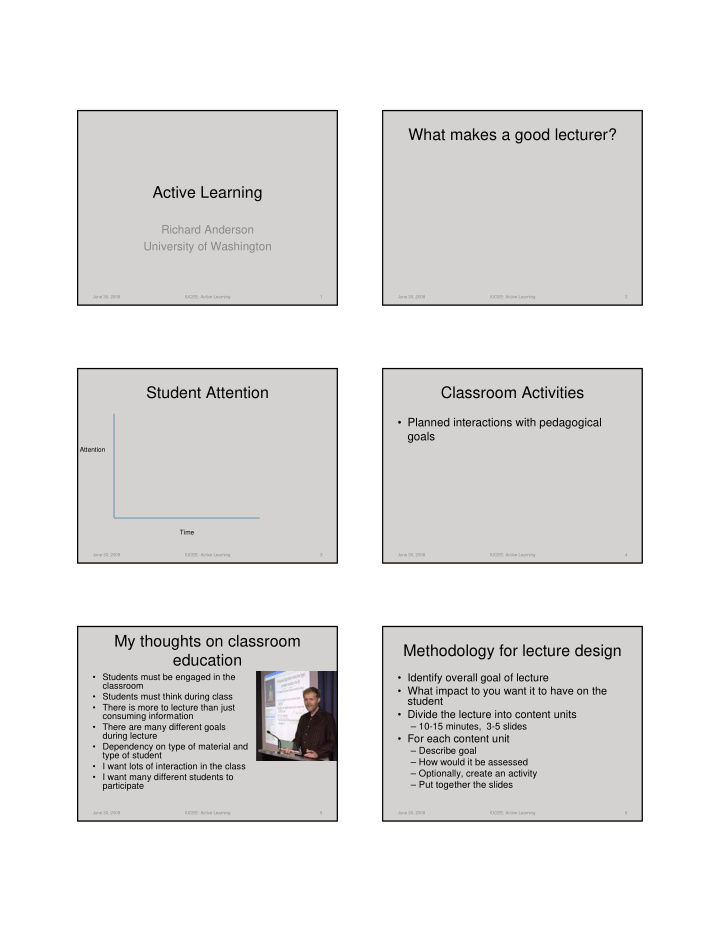



What makes a good lecturer? Active Learning Richard Anderson University of Washington June 30, 2008 IUCEE: Active Learning 1 June 30, 2008 IUCEE: Active Learning 2 Student Attention Classroom Activities • Planned interactions with pedagogical goals Attention Time June 30, 2008 IUCEE: Active Learning 3 June 30, 2008 IUCEE: Active Learning 4 My thoughts on classroom Methodology for lecture design education • Students must be engaged in the • Identify overall goal of lecture classroom • What impact to you want it to have on the • Students must think during class student • There is more to lecture than just • Divide the lecture into content units consuming information • There are many different goals – 10-15 minutes, 3-5 slides during lecture • For each content unit • Dependency on type of material and – Describe goal type of student – How would it be assessed • I want lots of interaction in the class – Optionally, create an activity • I want many different students to – Put together the slides participate June 30, 2008 IUCEE: Active Learning 5 June 30, 2008 IUCEE: Active Learning 6
Classroom Assessment What is the difference between formative and summative assessments? Techniques • Thomas Angelo, • Formative • Summative Patricia Cross • Introduce classroom assessment • Catalog of different assessment techniques June 30, 2008 IUCEE: Active Learning 7 June 30, 2008 IUCEE: Active Learning 8 Characteristics of classroom Seven basic assumptions of assessments Classroom Assessment 1. The quality of student learning is directly, • Learner centered although not exclusively, related to the • Teacher directed quality of teaching. Therefore, one of the most promising ways to improve learning is • Mutually beneficial to improve teaching. • Formative 2. To improve their effectiveness, teachers need first to make their goals and objectives • Context sensitive explicit and then to get specific, • Ongoing comprehensible feedback on the extent to which they are achieving those goals and • Rooted in good teaching practive objectives. June 30, 2008 IUCEE: Active Learning 9 June 30, 2008 IUCEE: Active Learning 10 Seven basic assumptions of Seven basic assumptions of Classroom Assessment Classroom Assessment 3. To improve their learning, students need to 5. Systematic inquiry and intellectual challenge are powerful sources of motivation, growth and receive appropriate and focused feedback renewal for college teachers, and Classroom early and often; they also need to learn how Assessment can provide such challenge. to assess their own learning. 6. Classroom Assessment does not require 4. The type of assessment most likely to specialized training; it can be carried out by improve teaching and learning is that dedicated teachers from all disciplines. conducted by faculty to answer questions 7. By collaborating with colleagues and actively they themselves have formulated in involving students in Classroom Assessment response to issues or problems in their own efforts, faculty (and students) enhance learning teaching and personal satisfaction. June 30, 2008 IUCEE: Active Learning 11 June 30, 2008 IUCEE: Active Learning 12
Classroom Activities Discussion Artifact • Pedagogical Goals • Use student generated example to explore different aspects of a topic • Classroom Activities • Assess overall understanding • Diagnose misconceptions Bangalore Precipitation and Temperature Bangalore Weather 40 200 30 150 Temperature Precipitation Daily average, mm per month degrees C 20 100 Use Red Use Blue 10 50 0 December January Student Submission June 30, 2008 IUCEE: Active Learning 16 Discovery Activity Topological Sort • Have students derive a concept from an • Given a set of tasks with precedence example constraints, find a linear order of the tasks 321 322 401 142 143 341 326 421 370 431 378 • Label vertices with integers 1, 2, . . ., n – If v precedes w, then l(v) < l(w)
Find a topological order for the following Collective Brainstorm graph • Generate student ideas for discussion • Build a list of ideas H E I A • Analyze and evaluate responses D G J C F K B L Special problem: Large Size Problem Introduction • Have students explore an instance of a problem before topic is introduced • List at least three problems trees must face (& solve) because of their large sizes. 1. 2. 3. 21 Submissions Determine the LCS of the following strings BARTHOLEMEWSIMPSON KRUSTYTHECLOWN 23
Handwriting Recognition: Challenge problems Identify the following words • Competition in getting solutions • Simultaneous work • Submission and discussion How many self intersections can a piecewise Problem solving linear curve with n segments have? • Problems for students submission • Allow all students to work on the problems (and not just the students who always answer first) • Observe student performance during activity June 30, 2008 IUCEE: Active Learning 27 June 30, 2008 IUCEE: Active Learning 28
Recommend
More recommend